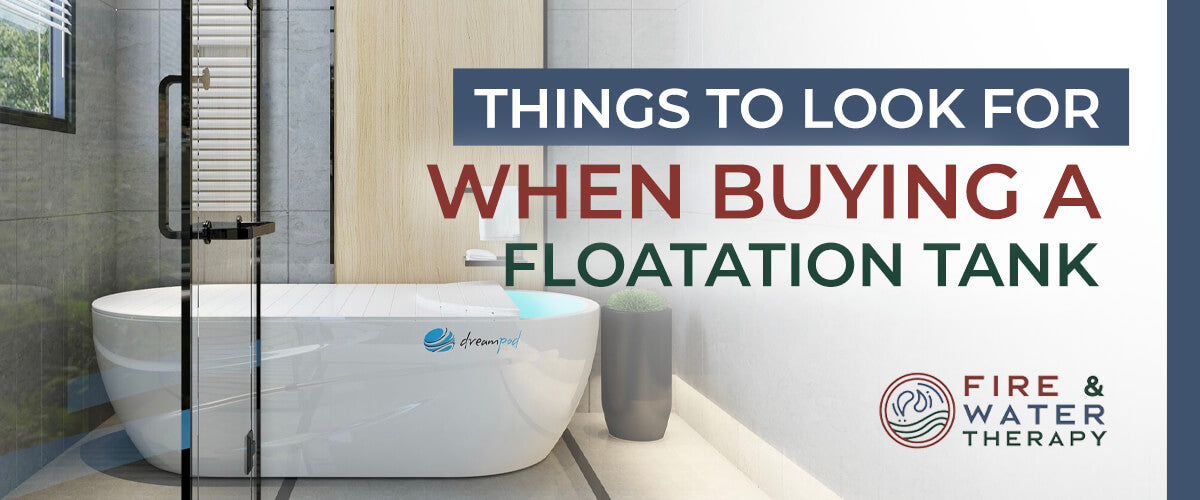Things to Look for When Buying a Floatation Tank

Selecting the ideal flotation tank can be difficult, as many buyers require assistance in understanding the various models. You need to figure out which features are key for relaxation and the best value for your money. These factors can make the decision-making process easy.
This article helps you choose the right flotation tank for your home or wellness center. It explains the tank models' differences. It highlights key features for relaxation and gives tips for a smart purchase. Keep reading to learn how to pick a floatation tank that suits your needs.
Understanding Floatation Tanks
What Is a Floatation Tank?
It’s a tank filled with water and a high concentration of Epsom salt, which allows a person to float on the surface. The tank is designed to block light and sound. It provides a unique environment for relaxation and meditation. Originally developed by neuroscientist John C. Lilly in the mid-20th century, floatation tanks have evolved to be more accessible and user-friendly.
Floatation therapy works by reducing outside noise and distractions. This lets your brain relax deeply, enhancing calmness and creativity. In the tank's quiet, your mind can focus better. This state also loosens muscles and slows breathing, improving well-being. The unique environment cuts down on sensory input, allowing the brain to produce theta waves. These waves are linked to deep relaxation and memory improvement.
Types of Sensory Deprivation Tanks
If you're thinking of trying one, it's good to know the different kinds available. This will help you pick the best one for you.
Pods

They are about 7 feet long and 4 feet wide. The top of the pod is curved, and it has a door at the back. You can leave the pod slightly open to let the air in. This helps keep the water at the perfect warm temperature of 94 degrees Fahrenheit.
Inside a pod, there is plenty of room to lie down and stretch out. The curved top makes sure you don’t feel closed in. The back opening makes it easy to get in and out. These are great for a cozy, calm floating experience.
Cabin

Cabin-style tanks are much bigger than pods. Once inside these tanks, individuals can effortlessly move around while standing upright. Some cabins have lights and sounds that you can control. This lets you make the floating experience just how you like it.
These big tanks are very private and quiet. They are perfect for people who want to be alone with their thoughts. The extra space helps you relax deeply.
Pool or Room

Open float rooms offer a unique floating experience, unlike traditional float tanks. They don't have enclosed spaces that need hatches to close them off. This open design allows for varying levels of sound and light control. It's especially beneficial for people with disabilities or those who fear enclosed spaces. It allows them to float calmly without feeling trapped.
It's essential to pick the right sensory deprivation tank for you. This depends on your comfort and preferences. Some prefer the cozy feel of a pod, while others prefer the spaciousness of a room. Understanding these differences helps you choose the tank that suits you best for a relaxing experience. Each type has its own way of promoting calmness and focus.
Understanding Technical Specifications
When you're thinking about buying a floatation tank, knowing the specs is important. These details determine how well the tank will meet your needs and expectations. Here's a guide on what to look for:
Size and Shape
Tanks vary in size and shape. A bigger tank gives you more room to move and might be more comfortable. The tank's shape affects how it fits in your space and its appearance, affecting your mood and expectations. Small tanks might feel cramped, while larger ones offer more freedom. Some tanks let you float with a partner.
Water Depth and Salinity
Most tanks are designed with a water depth of 10 to 12 inches. The water is heavily salted to ensure you float easily. The high salt content also has health advantages. These include cleansing your skin, soothing your muscles, and boosting your magnesium levels. Understanding this helps you ensure the tank meets standard specifications for effective floating.
Heating System
The water in the tank should be warmed to your skin's temperature, typically about 94-95 degrees Fahrenheit. This minimizes the sensation of the water against your skin. Make sure the system can keep this temperature steady. It's important for making you feel weightless and blending your body's edges.
Filtration System
A good filtration system is important for keeping the water clean and hygienic. It should include a pump, a filter, and often UV light to kill bacteria and viruses. Check that the system is capable of filtering out small particles and is easy to maintain.
Filter Size
The smaller the filter size, the better it can trap tiny particles. This helps keep the water exceptionally clean. Filters are measured in microns. Smaller numbers mean a finer filter, making it typically more effective.
Hydroxyl Radicals
Some tanks use advanced cleaning techniques. They use hydroxyl radicals, which involve silver-stabilized hydrogen peroxide and UVC light. This method effectively destroys bacteria and viruses, ensuring the water is safe for each use.
Ventilation System
Proper ventilation keeps the air fresh inside the tank and prevents moisture buildup. Different tanks use natural or mechanical ventilation, depending on how much airflow is needed. Knowing which type the tank uses helps you understand how it will manage air quality and noise.
Lighting System
Adjustable lighting can improve your experience in the tank. This feature is not essential for everyone. However, it can boost your floating experience by setting different moods. Some tanks have internal lighting, controlled from inside, while others use controls outside. The lights can be inside or outside the tank. Inside lights are controlled by switches or buttons you can reach. Outside lights are controlled by remotes or timers.
Sound System
Tanks may include a sound system for playing music or soothing sounds. Check whether the system is wired or wireless and how you can control it. Good sound systems can help you relax deeper and enjoy your float more.
Knowing these technical details before buying a float tank helps you pick one that fits your needs. It also makes it easier to maintain and use the tank for a better experience.
What to Look for When Choosing a Floatation Tank
Here are some things to consider when purchasing a flotation tank:
Quality and Durability
It should be built with strong materials that resist damage from salty water. Materials like fiberglass, acrylic, stainless steel, and titanium are good choices. The tank's design should be strong and comfy. It should have features like non-slip floors and easy entry and exit points.
Price and Value
Consider the upfront cost as well as ongoing expenses. A sensory deprivation tank for your home might range in price from $10,000 to $30,000. Look for features that save money in the long run. These include energy-efficient designs and high-quality filters. Fast customer service is important to reduce downtime, especially for commercial tanks.
Reviews and Ratings
Reading reviews from previous buyers can give you insight. They show a tank's performance and reliability. Good reviews mean a good product. However, it's essential to check many sources for a balanced view.
Filtration and Hygiene
A good filtration system keeps the water clean and safe. It should remove impurities, bacteria, and other harmful substances. Regular maintenance is necessary to keep the system working well.
Comfort Features
Adjustable lighting and sound systems enhance the floatation experience. The mood of the lighting should be soothing. Also, the sound system needs to deliver high-quality audio for music or meditation.
Choosing the right floatation tank requires careful consideration of these specifications. Whether for personal use or a business investment, selecting a tank that meets your needs is essential.
Benefits of Floatation Therapy
This therapy offers many health benefits for your body, mind, and emotions. Here's a closer look at how it helps:
Physical Benefits of Floating
- Relax Muscles and Reduce Pain: Floating relaxes your muscles. It also lessens pain from arthritis or sore backs.
- Help Your Body Heal Faster: You don't fight gravity while floating. This helps your blood flow better. It gets rid of body waste faster. This helps you heal faster from injuries.
- Boost Your Immune System: Floating reduces stress. This can make your immune system stronger. It helps you stay healthy.
Mental and Emotional Benefits
- Lower Stress and Anxiety: The tank is quiet and calm. It reduces stress by lowering cortisol. It increases happy chemicals in your brain.
- Improve Sleep: Floating can help if you can't sleep. It helps reset your body's sleep cycle.
- Think More Clearly: Fewer distractions help your brain. It can focus better. This helps you think more clearly and helps you be more creative.
Extra Unique Benefits
- Get More Magnesium: The tank's Epsom salts have magnesium. This mineral is good for your bones, heart, and blood. Floating helps your body absorb magnesium.
- Less Pressure from Gravity: Floating removes gravity's pressure. Your spine can stretch, and your blood flows freely.
- Refresh Your Mind: Floating helps you break habits. It makes you more aware. It helps you notice what you're doing.
Psychological and Cognitive Enhancements
- Change Negative Behaviors: Floating can change bad habits. It helps with smoking and improves calm.
- Help Your Brain Work Together: Research shows floating improves brain cooperation. It boosts creativity and logic.
- Better Self-Awareness and Planning: The tank's quiet is perfect for deep thought. It helps with personal growth. It helps prepare for big events.
Floatation therapy improves your health and well-being. It helps your body heal and your mind focus. Whether you need physical relief or mental clarity, floating is effective.
Conclusion
Choosing the right floatation tank involves understanding its benefits. It also requires knowing what features are crucial and being aware of different types. With the right information, buyers can find a tank that fits their needs and enhances their health and well-being. The key is to focus on quality, safety, and the specific features that will provide the best relaxation experience.
Discover relaxation like never before! Check out our selection of flotation tanks now and find your perfect match. Upgrade your wellness routine today!




